Analyzing Crime and Government's Response to Drug Problem: Essay
VerifiedAdded on 2023/05/26
|10
|2907
|68
Essay
AI Summary
This essay provides a comprehensive analysis of the definition of crime, exploring various perspectives including legal, sociological, and political viewpoints, and delves into the UK government's approach to addressing the drug problem. It examines the challenges in defining crime, presenting different interpretations and highlighting the complexities of the issue. The essay then focuses on the UK government's strategies, laws, and policies related to drug control, including drug classifications (Class A, B, and C) and the Psychoactive Substances Act 2016. Furthermore, it critically assesses the effectiveness of these policies, comparing them to other approaches, such as Singapore's strict laws, and considering the impact of legal drugs like alcohol. The essay concludes by summarizing the difficulties in defining crime and the complexities of the government’s response to the drug problem.

Running head: CRIME AND GOVERNMENT’S RESPONSE TO DRUG PROBLEM
CRIME AND GOVERNMENT’S RESPONSE TO DRUG PROBLEM
Name of the student
Name of the university
Author note
CRIME AND GOVERNMENT’S RESPONSE TO DRUG PROBLEM
Name of the student
Name of the university
Author note
Paraphrase This Document
Need a fresh take? Get an instant paraphrase of this document with our AI Paraphraser

1
CRIME AND GOVERNMENT’S RESPONSE TO DRUG PROBLEM
What is Crime?
Introduction
Crime does not have an easy definition and one must undertake extensive research to
define crime properly. Many definitions are there that often provide contradictory explanation of
crime that one must consider prior to defining the term. The fundamental question to ask
however is whether crime has any definition at all or not.
The assignment aims to present the definition of crime as per different perspectives. The
essay will first argue about the difficulty in defining crime followed by the different versions of
it. Then, the essay will expand the definition of crime as per the different versions.
Discussion
Several versions of crime definitions are there in the lexicon. As per the dictionary
version, crime is an act that has been prohibited by the law and if carried out, it is punishable.
Lord Atkin provided one of the earliest legalistic definitions of crime. According to him,
whatever the state decides to be crime for the time being is crime. This definition shows that the
state defines the crime and that crime’s definition is fluid and might change over time. Lord
Atkin also explained the problems related to the definition of crime. He stated that crime cannot
be clearly defined because the institution cannot discern the criminal quality of an act neither any
reference to some standard could discover it.
Crime thus, can be defined in many ways and yet cannot be defined at all. The several
versions of crime’s definition include crime as legal codes breach as has been mentioned above,
as breach of norms, as a form of deviance, as a social construct and human rights breach. In
CRIME AND GOVERNMENT’S RESPONSE TO DRUG PROBLEM
What is Crime?
Introduction
Crime does not have an easy definition and one must undertake extensive research to
define crime properly. Many definitions are there that often provide contradictory explanation of
crime that one must consider prior to defining the term. The fundamental question to ask
however is whether crime has any definition at all or not.
The assignment aims to present the definition of crime as per different perspectives. The
essay will first argue about the difficulty in defining crime followed by the different versions of
it. Then, the essay will expand the definition of crime as per the different versions.
Discussion
Several versions of crime definitions are there in the lexicon. As per the dictionary
version, crime is an act that has been prohibited by the law and if carried out, it is punishable.
Lord Atkin provided one of the earliest legalistic definitions of crime. According to him,
whatever the state decides to be crime for the time being is crime. This definition shows that the
state defines the crime and that crime’s definition is fluid and might change over time. Lord
Atkin also explained the problems related to the definition of crime. He stated that crime cannot
be clearly defined because the institution cannot discern the criminal quality of an act neither any
reference to some standard could discover it.
Crime thus, can be defined in many ways and yet cannot be defined at all. The several
versions of crime’s definition include crime as legal codes breach as has been mentioned above,
as breach of norms, as a form of deviance, as a social construct and human rights breach. In
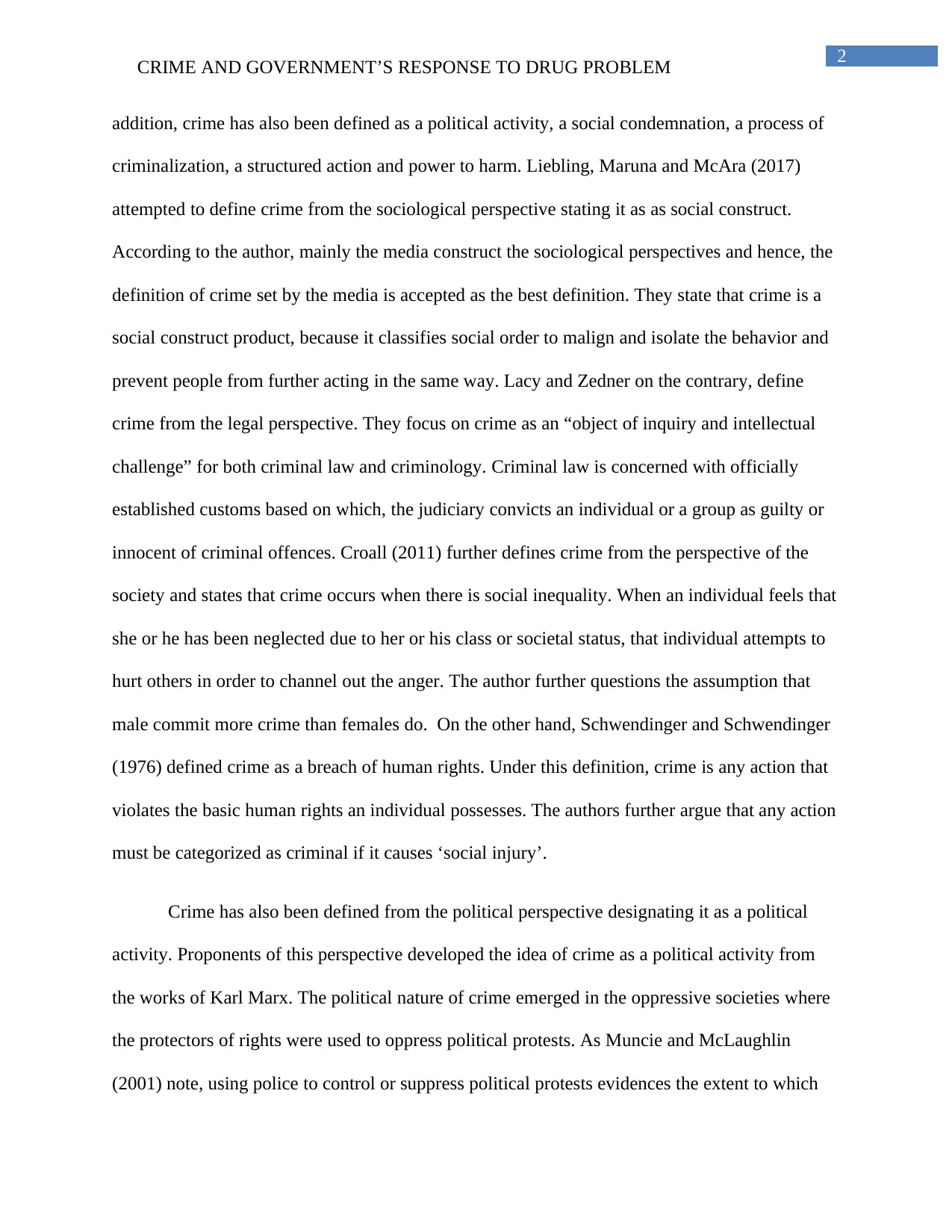
2
CRIME AND GOVERNMENT’S RESPONSE TO DRUG PROBLEM
addition, crime has also been defined as a political activity, a social condemnation, a process of
criminalization, a structured action and power to harm. Liebling, Maruna and McAra (2017)
attempted to define crime from the sociological perspective stating it as as social construct.
According to the author, mainly the media construct the sociological perspectives and hence, the
definition of crime set by the media is accepted as the best definition. They state that crime is a
social construct product, because it classifies social order to malign and isolate the behavior and
prevent people from further acting in the same way. Lacy and Zedner on the contrary, define
crime from the legal perspective. They focus on crime as an “object of inquiry and intellectual
challenge” for both criminal law and criminology. Criminal law is concerned with officially
established customs based on which, the judiciary convicts an individual or a group as guilty or
innocent of criminal offences. Croall (2011) further defines crime from the perspective of the
society and states that crime occurs when there is social inequality. When an individual feels that
she or he has been neglected due to her or his class or societal status, that individual attempts to
hurt others in order to channel out the anger. The author further questions the assumption that
male commit more crime than females do. On the other hand, Schwendinger and Schwendinger
(1976) defined crime as a breach of human rights. Under this definition, crime is any action that
violates the basic human rights an individual possesses. The authors further argue that any action
must be categorized as criminal if it causes ‘social injury’.
Crime has also been defined from the political perspective designating it as a political
activity. Proponents of this perspective developed the idea of crime as a political activity from
the works of Karl Marx. The political nature of crime emerged in the oppressive societies where
the protectors of rights were used to oppress political protests. As Muncie and McLaughlin
(2001) note, using police to control or suppress political protests evidences the extent to which
CRIME AND GOVERNMENT’S RESPONSE TO DRUG PROBLEM
addition, crime has also been defined as a political activity, a social condemnation, a process of
criminalization, a structured action and power to harm. Liebling, Maruna and McAra (2017)
attempted to define crime from the sociological perspective stating it as as social construct.
According to the author, mainly the media construct the sociological perspectives and hence, the
definition of crime set by the media is accepted as the best definition. They state that crime is a
social construct product, because it classifies social order to malign and isolate the behavior and
prevent people from further acting in the same way. Lacy and Zedner on the contrary, define
crime from the legal perspective. They focus on crime as an “object of inquiry and intellectual
challenge” for both criminal law and criminology. Criminal law is concerned with officially
established customs based on which, the judiciary convicts an individual or a group as guilty or
innocent of criminal offences. Croall (2011) further defines crime from the perspective of the
society and states that crime occurs when there is social inequality. When an individual feels that
she or he has been neglected due to her or his class or societal status, that individual attempts to
hurt others in order to channel out the anger. The author further questions the assumption that
male commit more crime than females do. On the other hand, Schwendinger and Schwendinger
(1976) defined crime as a breach of human rights. Under this definition, crime is any action that
violates the basic human rights an individual possesses. The authors further argue that any action
must be categorized as criminal if it causes ‘social injury’.
Crime has also been defined from the political perspective designating it as a political
activity. Proponents of this perspective developed the idea of crime as a political activity from
the works of Karl Marx. The political nature of crime emerged in the oppressive societies where
the protectors of rights were used to oppress political protests. As Muncie and McLaughlin
(2001) note, using police to control or suppress political protests evidences the extent to which
⊘ This is a preview!⊘
Do you want full access?
Subscribe today to unlock all pages.

Trusted by 1+ million students worldwide
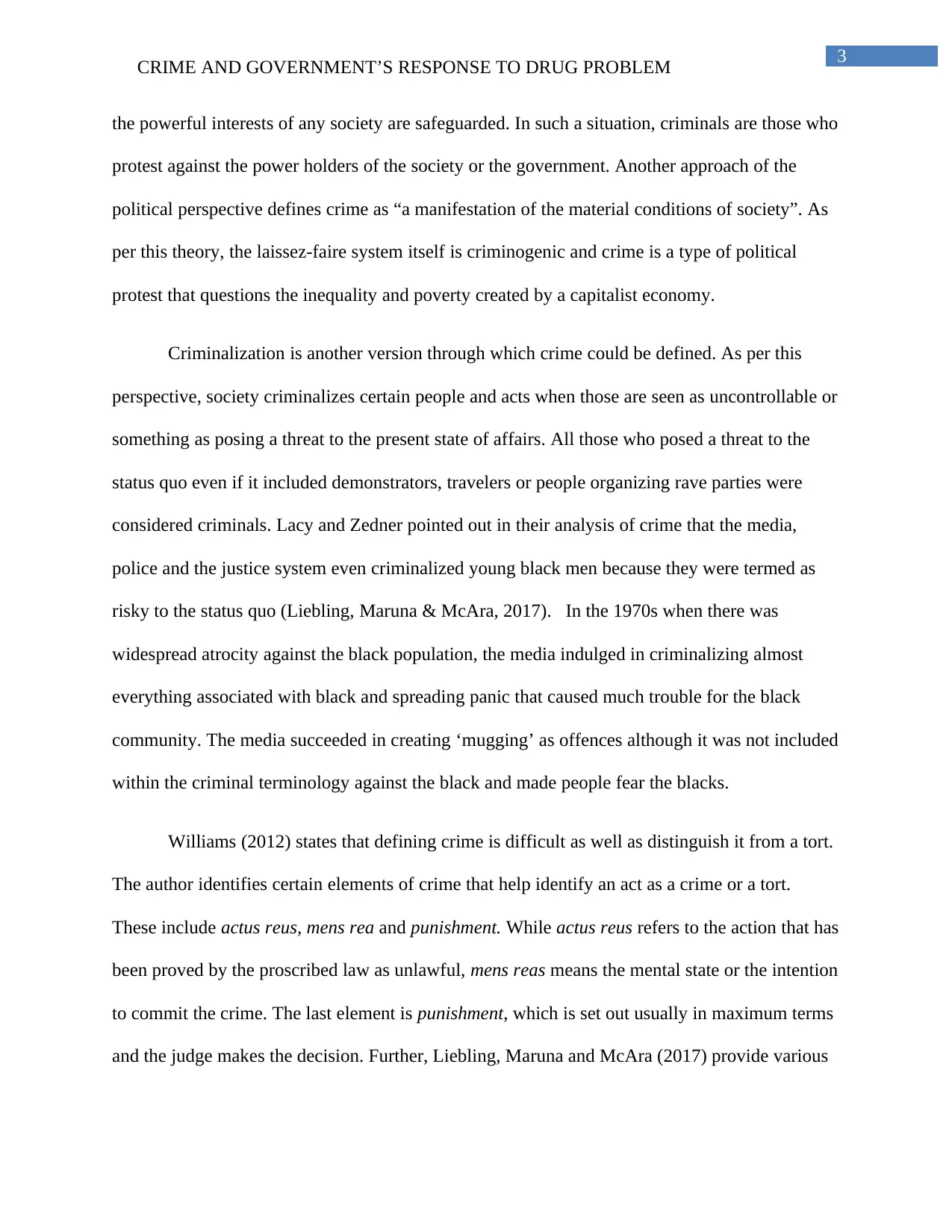
3
CRIME AND GOVERNMENT’S RESPONSE TO DRUG PROBLEM
the powerful interests of any society are safeguarded. In such a situation, criminals are those who
protest against the power holders of the society or the government. Another approach of the
political perspective defines crime as “a manifestation of the material conditions of society”. As
per this theory, the laissez-faire system itself is criminogenic and crime is a type of political
protest that questions the inequality and poverty created by a capitalist economy.
Criminalization is another version through which crime could be defined. As per this
perspective, society criminalizes certain people and acts when those are seen as uncontrollable or
something as posing a threat to the present state of affairs. All those who posed a threat to the
status quo even if it included demonstrators, travelers or people organizing rave parties were
considered criminals. Lacy and Zedner pointed out in their analysis of crime that the media,
police and the justice system even criminalized young black men because they were termed as
risky to the status quo (Liebling, Maruna & McAra, 2017). In the 1970s when there was
widespread atrocity against the black population, the media indulged in criminalizing almost
everything associated with black and spreading panic that caused much trouble for the black
community. The media succeeded in creating ‘mugging’ as offences although it was not included
within the criminal terminology against the black and made people fear the blacks.
Williams (2012) states that defining crime is difficult as well as distinguish it from a tort.
The author identifies certain elements of crime that help identify an act as a crime or a tort.
These include actus reus, mens rea and punishment. While actus reus refers to the action that has
been proved by the proscribed law as unlawful, mens reas means the mental state or the intention
to commit the crime. The last element is punishment, which is set out usually in maximum terms
and the judge makes the decision. Further, Liebling, Maruna and McAra (2017) provide various
CRIME AND GOVERNMENT’S RESPONSE TO DRUG PROBLEM
the powerful interests of any society are safeguarded. In such a situation, criminals are those who
protest against the power holders of the society or the government. Another approach of the
political perspective defines crime as “a manifestation of the material conditions of society”. As
per this theory, the laissez-faire system itself is criminogenic and crime is a type of political
protest that questions the inequality and poverty created by a capitalist economy.
Criminalization is another version through which crime could be defined. As per this
perspective, society criminalizes certain people and acts when those are seen as uncontrollable or
something as posing a threat to the present state of affairs. All those who posed a threat to the
status quo even if it included demonstrators, travelers or people organizing rave parties were
considered criminals. Lacy and Zedner pointed out in their analysis of crime that the media,
police and the justice system even criminalized young black men because they were termed as
risky to the status quo (Liebling, Maruna & McAra, 2017). In the 1970s when there was
widespread atrocity against the black population, the media indulged in criminalizing almost
everything associated with black and spreading panic that caused much trouble for the black
community. The media succeeded in creating ‘mugging’ as offences although it was not included
within the criminal terminology against the black and made people fear the blacks.
Williams (2012) states that defining crime is difficult as well as distinguish it from a tort.
The author identifies certain elements of crime that help identify an act as a crime or a tort.
These include actus reus, mens rea and punishment. While actus reus refers to the action that has
been proved by the proscribed law as unlawful, mens reas means the mental state or the intention
to commit the crime. The last element is punishment, which is set out usually in maximum terms
and the judge makes the decision. Further, Liebling, Maruna and McAra (2017) provide various
Paraphrase This Document
Need a fresh take? Get an instant paraphrase of this document with our AI Paraphraser
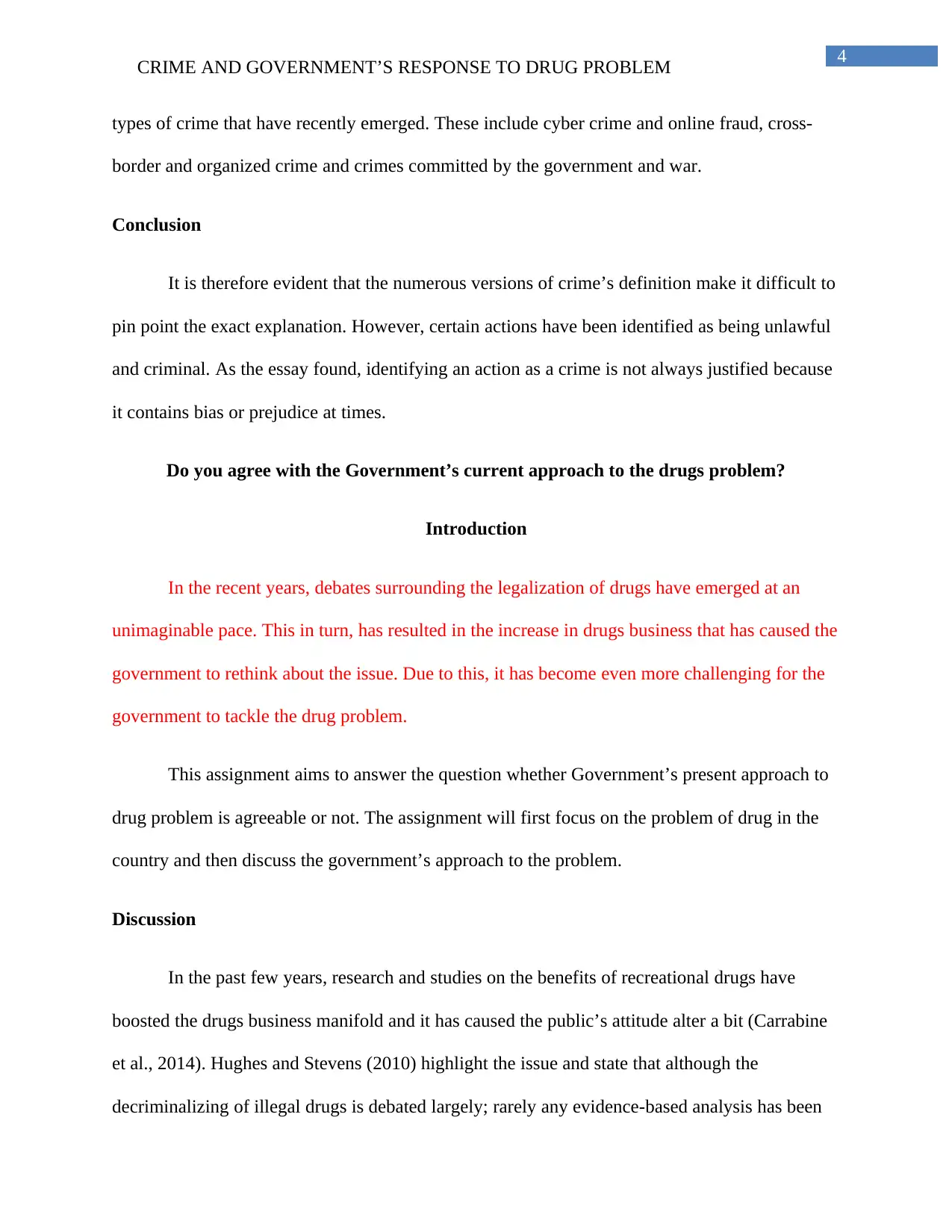
4
CRIME AND GOVERNMENT’S RESPONSE TO DRUG PROBLEM
types of crime that have recently emerged. These include cyber crime and online fraud, cross-
border and organized crime and crimes committed by the government and war.
Conclusion
It is therefore evident that the numerous versions of crime’s definition make it difficult to
pin point the exact explanation. However, certain actions have been identified as being unlawful
and criminal. As the essay found, identifying an action as a crime is not always justified because
it contains bias or prejudice at times.
Do you agree with the Government’s current approach to the drugs problem?
Introduction
In the recent years, debates surrounding the legalization of drugs have emerged at an
unimaginable pace. This in turn, has resulted in the increase in drugs business that has caused the
government to rethink about the issue. Due to this, it has become even more challenging for the
government to tackle the drug problem.
This assignment aims to answer the question whether Government’s present approach to
drug problem is agreeable or not. The assignment will first focus on the problem of drug in the
country and then discuss the government’s approach to the problem.
Discussion
In the past few years, research and studies on the benefits of recreational drugs have
boosted the drugs business manifold and it has caused the public’s attitude alter a bit (Carrabine
et al., 2014). Hughes and Stevens (2010) highlight the issue and state that although the
decriminalizing of illegal drugs is debated largely; rarely any evidence-based analysis has been
CRIME AND GOVERNMENT’S RESPONSE TO DRUG PROBLEM
types of crime that have recently emerged. These include cyber crime and online fraud, cross-
border and organized crime and crimes committed by the government and war.
Conclusion
It is therefore evident that the numerous versions of crime’s definition make it difficult to
pin point the exact explanation. However, certain actions have been identified as being unlawful
and criminal. As the essay found, identifying an action as a crime is not always justified because
it contains bias or prejudice at times.
Do you agree with the Government’s current approach to the drugs problem?
Introduction
In the recent years, debates surrounding the legalization of drugs have emerged at an
unimaginable pace. This in turn, has resulted in the increase in drugs business that has caused the
government to rethink about the issue. Due to this, it has become even more challenging for the
government to tackle the drug problem.
This assignment aims to answer the question whether Government’s present approach to
drug problem is agreeable or not. The assignment will first focus on the problem of drug in the
country and then discuss the government’s approach to the problem.
Discussion
In the past few years, research and studies on the benefits of recreational drugs have
boosted the drugs business manifold and it has caused the public’s attitude alter a bit (Carrabine
et al., 2014). Hughes and Stevens (2010) highlight the issue and state that although the
decriminalizing of illegal drugs is debated largely; rarely any evidence-based analysis has been
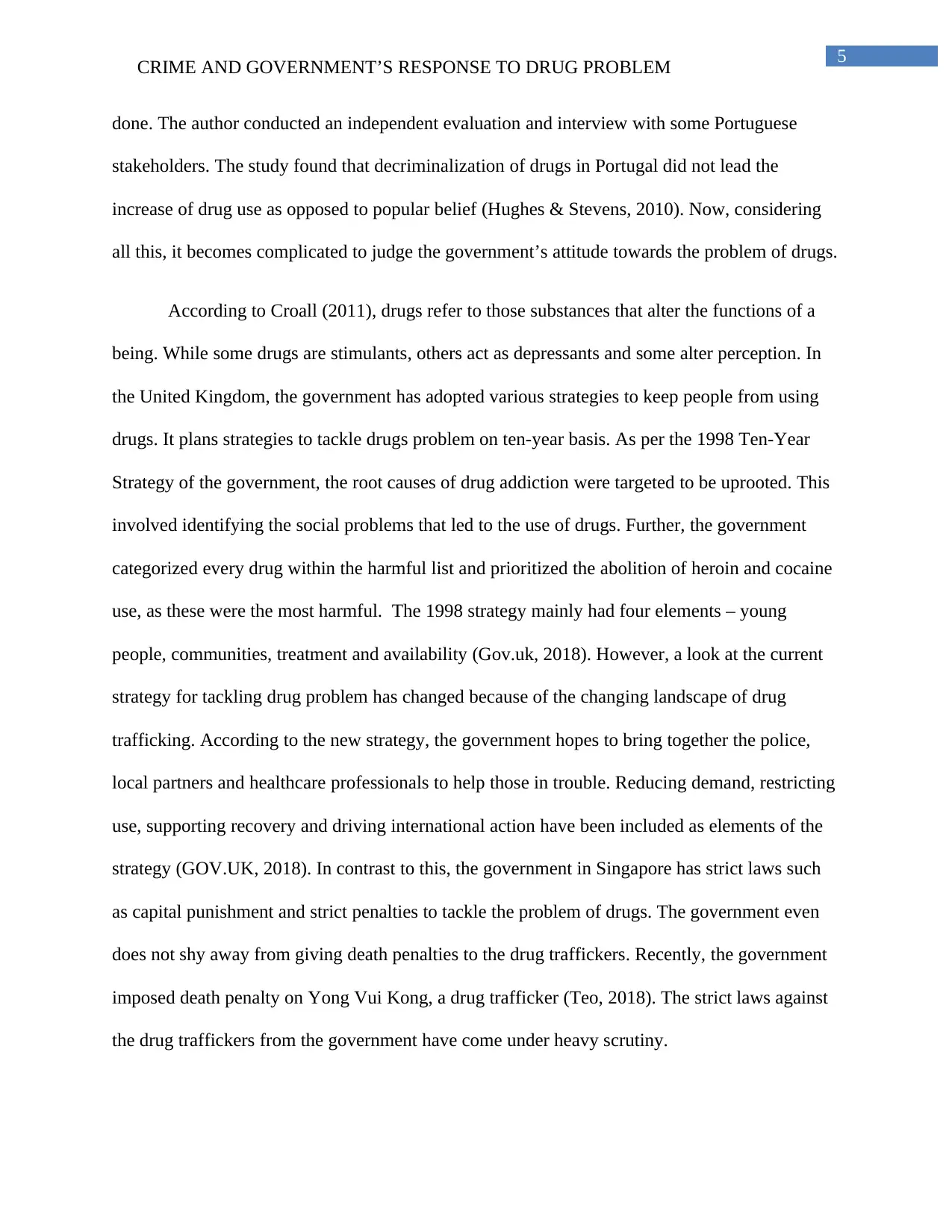
5
CRIME AND GOVERNMENT’S RESPONSE TO DRUG PROBLEM
done. The author conducted an independent evaluation and interview with some Portuguese
stakeholders. The study found that decriminalization of drugs in Portugal did not lead the
increase of drug use as opposed to popular belief (Hughes & Stevens, 2010). Now, considering
all this, it becomes complicated to judge the government’s attitude towards the problem of drugs.
According to Croall (2011), drugs refer to those substances that alter the functions of a
being. While some drugs are stimulants, others act as depressants and some alter perception. In
the United Kingdom, the government has adopted various strategies to keep people from using
drugs. It plans strategies to tackle drugs problem on ten-year basis. As per the 1998 Ten-Year
Strategy of the government, the root causes of drug addiction were targeted to be uprooted. This
involved identifying the social problems that led to the use of drugs. Further, the government
categorized every drug within the harmful list and prioritized the abolition of heroin and cocaine
use, as these were the most harmful. The 1998 strategy mainly had four elements – young
people, communities, treatment and availability (Gov.uk, 2018). However, a look at the current
strategy for tackling drug problem has changed because of the changing landscape of drug
trafficking. According to the new strategy, the government hopes to bring together the police,
local partners and healthcare professionals to help those in trouble. Reducing demand, restricting
use, supporting recovery and driving international action have been included as elements of the
strategy (GOV.UK, 2018). In contrast to this, the government in Singapore has strict laws such
as capital punishment and strict penalties to tackle the problem of drugs. The government even
does not shy away from giving death penalties to the drug traffickers. Recently, the government
imposed death penalty on Yong Vui Kong, a drug trafficker (Teo, 2018). The strict laws against
the drug traffickers from the government have come under heavy scrutiny.
CRIME AND GOVERNMENT’S RESPONSE TO DRUG PROBLEM
done. The author conducted an independent evaluation and interview with some Portuguese
stakeholders. The study found that decriminalization of drugs in Portugal did not lead the
increase of drug use as opposed to popular belief (Hughes & Stevens, 2010). Now, considering
all this, it becomes complicated to judge the government’s attitude towards the problem of drugs.
According to Croall (2011), drugs refer to those substances that alter the functions of a
being. While some drugs are stimulants, others act as depressants and some alter perception. In
the United Kingdom, the government has adopted various strategies to keep people from using
drugs. It plans strategies to tackle drugs problem on ten-year basis. As per the 1998 Ten-Year
Strategy of the government, the root causes of drug addiction were targeted to be uprooted. This
involved identifying the social problems that led to the use of drugs. Further, the government
categorized every drug within the harmful list and prioritized the abolition of heroin and cocaine
use, as these were the most harmful. The 1998 strategy mainly had four elements – young
people, communities, treatment and availability (Gov.uk, 2018). However, a look at the current
strategy for tackling drug problem has changed because of the changing landscape of drug
trafficking. According to the new strategy, the government hopes to bring together the police,
local partners and healthcare professionals to help those in trouble. Reducing demand, restricting
use, supporting recovery and driving international action have been included as elements of the
strategy (GOV.UK, 2018). In contrast to this, the government in Singapore has strict laws such
as capital punishment and strict penalties to tackle the problem of drugs. The government even
does not shy away from giving death penalties to the drug traffickers. Recently, the government
imposed death penalty on Yong Vui Kong, a drug trafficker (Teo, 2018). The strict laws against
the drug traffickers from the government have come under heavy scrutiny.
⊘ This is a preview!⊘
Do you want full access?
Subscribe today to unlock all pages.

Trusted by 1+ million students worldwide
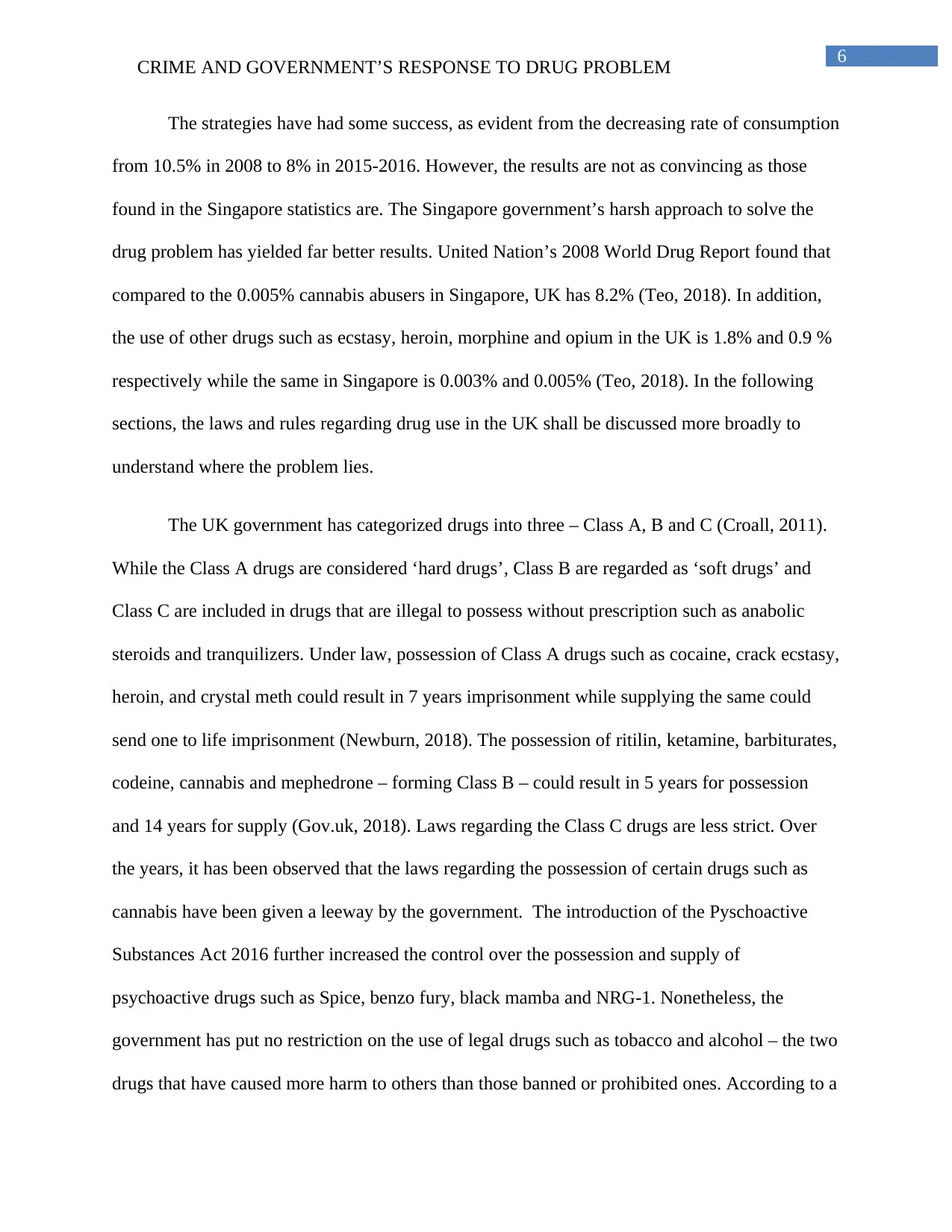
6
CRIME AND GOVERNMENT’S RESPONSE TO DRUG PROBLEM
The strategies have had some success, as evident from the decreasing rate of consumption
from 10.5% in 2008 to 8% in 2015-2016. However, the results are not as convincing as those
found in the Singapore statistics are. The Singapore government’s harsh approach to solve the
drug problem has yielded far better results. United Nation’s 2008 World Drug Report found that
compared to the 0.005% cannabis abusers in Singapore, UK has 8.2% (Teo, 2018). In addition,
the use of other drugs such as ecstasy, heroin, morphine and opium in the UK is 1.8% and 0.9 %
respectively while the same in Singapore is 0.003% and 0.005% (Teo, 2018). In the following
sections, the laws and rules regarding drug use in the UK shall be discussed more broadly to
understand where the problem lies.
The UK government has categorized drugs into three – Class A, B and C (Croall, 2011).
While the Class A drugs are considered ‘hard drugs’, Class B are regarded as ‘soft drugs’ and
Class C are included in drugs that are illegal to possess without prescription such as anabolic
steroids and tranquilizers. Under law, possession of Class A drugs such as cocaine, crack ecstasy,
heroin, and crystal meth could result in 7 years imprisonment while supplying the same could
send one to life imprisonment (Newburn, 2018). The possession of ritilin, ketamine, barbiturates,
codeine, cannabis and mephedrone – forming Class B – could result in 5 years for possession
and 14 years for supply (Gov.uk, 2018). Laws regarding the Class C drugs are less strict. Over
the years, it has been observed that the laws regarding the possession of certain drugs such as
cannabis have been given a leeway by the government. The introduction of the Pyschoactive
Substances Act 2016 further increased the control over the possession and supply of
psychoactive drugs such as Spice, benzo fury, black mamba and NRG-1. Nonetheless, the
government has put no restriction on the use of legal drugs such as tobacco and alcohol – the two
drugs that have caused more harm to others than those banned or prohibited ones. According to a
CRIME AND GOVERNMENT’S RESPONSE TO DRUG PROBLEM
The strategies have had some success, as evident from the decreasing rate of consumption
from 10.5% in 2008 to 8% in 2015-2016. However, the results are not as convincing as those
found in the Singapore statistics are. The Singapore government’s harsh approach to solve the
drug problem has yielded far better results. United Nation’s 2008 World Drug Report found that
compared to the 0.005% cannabis abusers in Singapore, UK has 8.2% (Teo, 2018). In addition,
the use of other drugs such as ecstasy, heroin, morphine and opium in the UK is 1.8% and 0.9 %
respectively while the same in Singapore is 0.003% and 0.005% (Teo, 2018). In the following
sections, the laws and rules regarding drug use in the UK shall be discussed more broadly to
understand where the problem lies.
The UK government has categorized drugs into three – Class A, B and C (Croall, 2011).
While the Class A drugs are considered ‘hard drugs’, Class B are regarded as ‘soft drugs’ and
Class C are included in drugs that are illegal to possess without prescription such as anabolic
steroids and tranquilizers. Under law, possession of Class A drugs such as cocaine, crack ecstasy,
heroin, and crystal meth could result in 7 years imprisonment while supplying the same could
send one to life imprisonment (Newburn, 2018). The possession of ritilin, ketamine, barbiturates,
codeine, cannabis and mephedrone – forming Class B – could result in 5 years for possession
and 14 years for supply (Gov.uk, 2018). Laws regarding the Class C drugs are less strict. Over
the years, it has been observed that the laws regarding the possession of certain drugs such as
cannabis have been given a leeway by the government. The introduction of the Pyschoactive
Substances Act 2016 further increased the control over the possession and supply of
psychoactive drugs such as Spice, benzo fury, black mamba and NRG-1. Nonetheless, the
government has put no restriction on the use of legal drugs such as tobacco and alcohol – the two
drugs that have caused more harm to others than those banned or prohibited ones. According to a
Paraphrase This Document
Need a fresh take? Get an instant paraphrase of this document with our AI Paraphraser

7
CRIME AND GOVERNMENT’S RESPONSE TO DRUG PROBLEM
survey result, alcohol has been the most harmful drug because its overall score – harm to others
and harm to the user crossed the 70 mark, the highest than any other drug (Nutt et al., 2010).
The concern therefore, should be on restricting the consumption and supply of alcohol
rather than just on other drugs. The strategy or approach taken by the government is not
complete or even correct because it does not dig deep into the problem of drug and only touches
the surface. In addition, the government must adopt a broader vision to help the people indulged
in excessive use of recreational drugs. Pickford (2012) in her analysis of drug problem and
growth of crime amongst youth, she argues that recreational drug use has become mainstream
amongst the youth and there is a need for a “reformed youth justice system”. The author
recognizes that “young offenders have often experienced multiple social difficulties and are,
therefore, at risk of developing problematic drug use” (Pickford, 2012). As could be seen, the
rise in the use of recreational drugs amongst the youth is linked to the social problems they face
and the government needs to focus on those rather than amending and adding laws and rules.
Conclusion
In the end, it can be stated that although the laws and rules imposed by the government
has yielded some positive results, it needs to focus more on restricting drugs that cause more
harm. After the analysis, it can be argued that the government’s current approach to the drugs
problem is partially agreeable. This is because it needs to focus more restricting legal drugs like
alcohol because it has caused the major trouble for the public.
CRIME AND GOVERNMENT’S RESPONSE TO DRUG PROBLEM
survey result, alcohol has been the most harmful drug because its overall score – harm to others
and harm to the user crossed the 70 mark, the highest than any other drug (Nutt et al., 2010).
The concern therefore, should be on restricting the consumption and supply of alcohol
rather than just on other drugs. The strategy or approach taken by the government is not
complete or even correct because it does not dig deep into the problem of drug and only touches
the surface. In addition, the government must adopt a broader vision to help the people indulged
in excessive use of recreational drugs. Pickford (2012) in her analysis of drug problem and
growth of crime amongst youth, she argues that recreational drug use has become mainstream
amongst the youth and there is a need for a “reformed youth justice system”. The author
recognizes that “young offenders have often experienced multiple social difficulties and are,
therefore, at risk of developing problematic drug use” (Pickford, 2012). As could be seen, the
rise in the use of recreational drugs amongst the youth is linked to the social problems they face
and the government needs to focus on those rather than amending and adding laws and rules.
Conclusion
In the end, it can be stated that although the laws and rules imposed by the government
has yielded some positive results, it needs to focus more on restricting drugs that cause more
harm. After the analysis, it can be argued that the government’s current approach to the drugs
problem is partially agreeable. This is because it needs to focus more restricting legal drugs like
alcohol because it has caused the major trouble for the public.
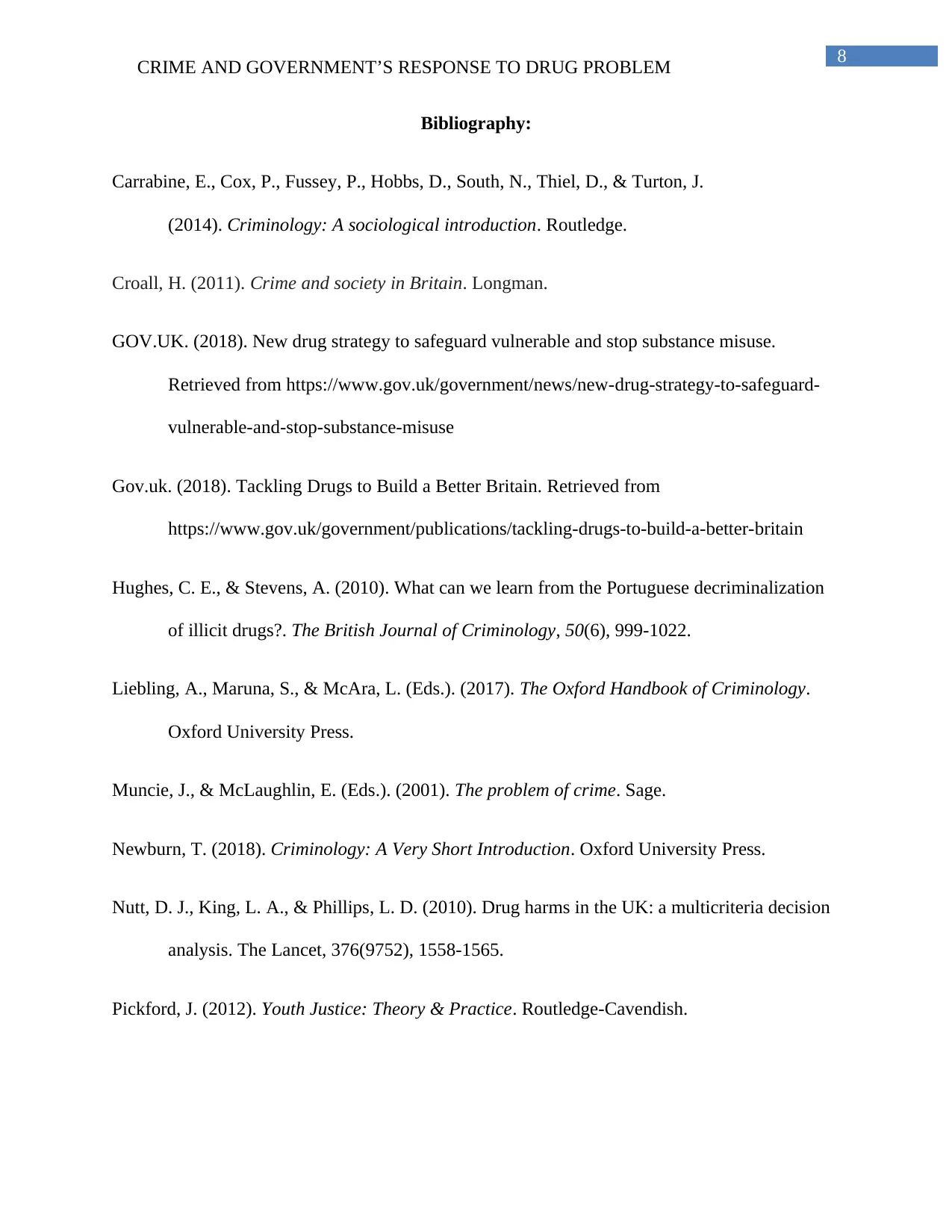
8
CRIME AND GOVERNMENT’S RESPONSE TO DRUG PROBLEM
Bibliography:
Carrabine, E., Cox, P., Fussey, P., Hobbs, D., South, N., Thiel, D., & Turton, J.
(2014). Criminology: A sociological introduction. Routledge.
Croall, H. (2011). Crime and society in Britain. Longman.
GOV.UK. (2018). New drug strategy to safeguard vulnerable and stop substance misuse.
Retrieved from https://www.gov.uk/government/news/new-drug-strategy-to-safeguard-
vulnerable-and-stop-substance-misuse
Gov.uk. (2018). Tackling Drugs to Build a Better Britain. Retrieved from
https://www.gov.uk/government/publications/tackling-drugs-to-build-a-better-britain
Hughes, C. E., & Stevens, A. (2010). What can we learn from the Portuguese decriminalization
of illicit drugs?. The British Journal of Criminology, 50(6), 999-1022.
Liebling, A., Maruna, S., & McAra, L. (Eds.). (2017). The Oxford Handbook of Criminology.
Oxford University Press.
Muncie, J., & McLaughlin, E. (Eds.). (2001). The problem of crime. Sage.
Newburn, T. (2018). Criminology: A Very Short Introduction. Oxford University Press.
Nutt, D. J., King, L. A., & Phillips, L. D. (2010). Drug harms in the UK: a multicriteria decision
analysis. The Lancet, 376(9752), 1558-1565.
Pickford, J. (2012). Youth Justice: Theory & Practice. Routledge-Cavendish.
CRIME AND GOVERNMENT’S RESPONSE TO DRUG PROBLEM
Bibliography:
Carrabine, E., Cox, P., Fussey, P., Hobbs, D., South, N., Thiel, D., & Turton, J.
(2014). Criminology: A sociological introduction. Routledge.
Croall, H. (2011). Crime and society in Britain. Longman.
GOV.UK. (2018). New drug strategy to safeguard vulnerable and stop substance misuse.
Retrieved from https://www.gov.uk/government/news/new-drug-strategy-to-safeguard-
vulnerable-and-stop-substance-misuse
Gov.uk. (2018). Tackling Drugs to Build a Better Britain. Retrieved from
https://www.gov.uk/government/publications/tackling-drugs-to-build-a-better-britain
Hughes, C. E., & Stevens, A. (2010). What can we learn from the Portuguese decriminalization
of illicit drugs?. The British Journal of Criminology, 50(6), 999-1022.
Liebling, A., Maruna, S., & McAra, L. (Eds.). (2017). The Oxford Handbook of Criminology.
Oxford University Press.
Muncie, J., & McLaughlin, E. (Eds.). (2001). The problem of crime. Sage.
Newburn, T. (2018). Criminology: A Very Short Introduction. Oxford University Press.
Nutt, D. J., King, L. A., & Phillips, L. D. (2010). Drug harms in the UK: a multicriteria decision
analysis. The Lancet, 376(9752), 1558-1565.
Pickford, J. (2012). Youth Justice: Theory & Practice. Routledge-Cavendish.
⊘ This is a preview!⊘
Do you want full access?
Subscribe today to unlock all pages.

Trusted by 1+ million students worldwide
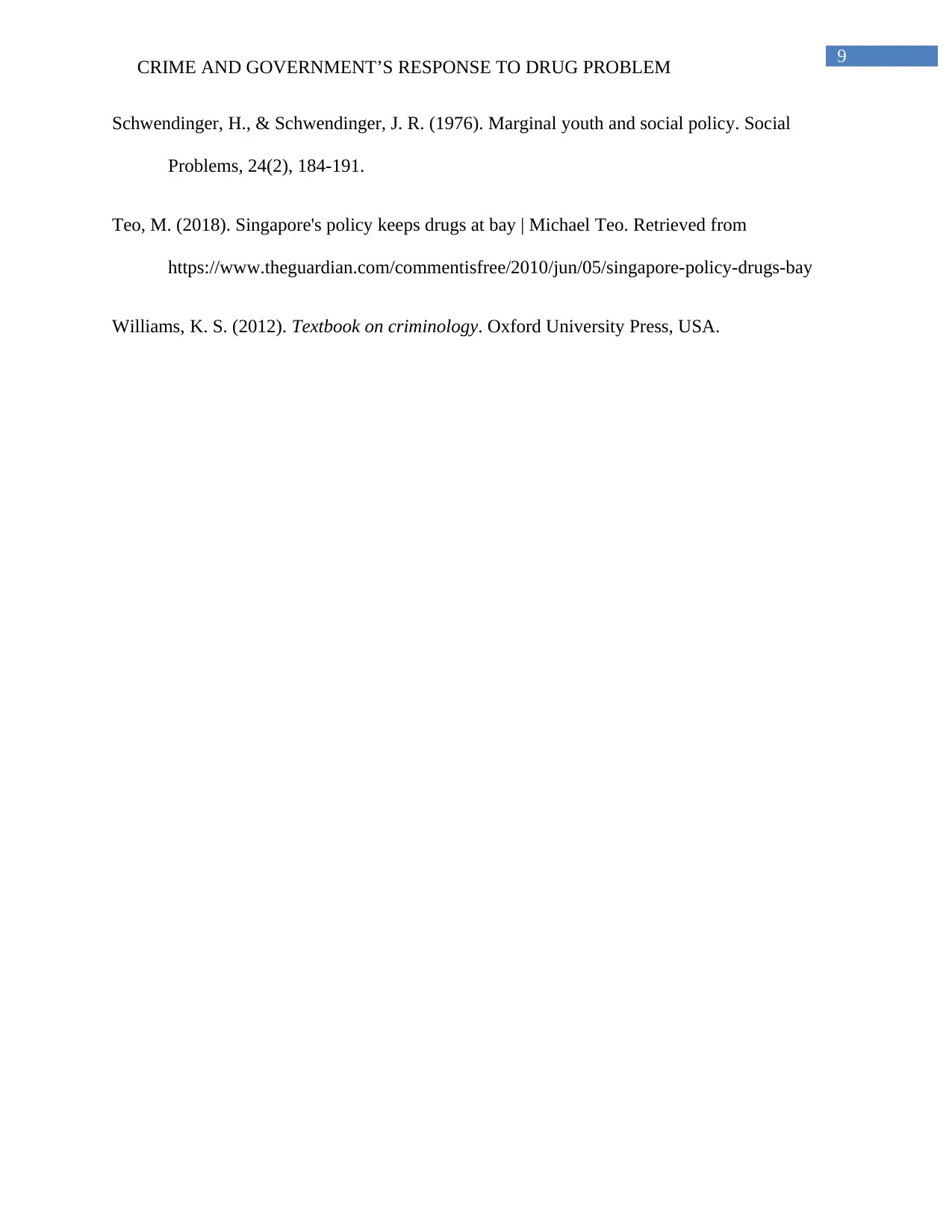
9
CRIME AND GOVERNMENT’S RESPONSE TO DRUG PROBLEM
Schwendinger, H., & Schwendinger, J. R. (1976). Marginal youth and social policy. Social
Problems, 24(2), 184-191.
Teo, M. (2018). Singapore's policy keeps drugs at bay | Michael Teo. Retrieved from
https://www.theguardian.com/commentisfree/2010/jun/05/singapore-policy-drugs-bay
Williams, K. S. (2012). Textbook on criminology. Oxford University Press, USA.
CRIME AND GOVERNMENT’S RESPONSE TO DRUG PROBLEM
Schwendinger, H., & Schwendinger, J. R. (1976). Marginal youth and social policy. Social
Problems, 24(2), 184-191.
Teo, M. (2018). Singapore's policy keeps drugs at bay | Michael Teo. Retrieved from
https://www.theguardian.com/commentisfree/2010/jun/05/singapore-policy-drugs-bay
Williams, K. S. (2012). Textbook on criminology. Oxford University Press, USA.
1 out of 10
Related Documents
Your All-in-One AI-Powered Toolkit for Academic Success.
+13062052269
info@desklib.com
Available 24*7 on WhatsApp / Email
![[object Object]](/_next/static/media/star-bottom.7253800d.svg)
Unlock your academic potential
Copyright © 2020–2025 A2Z Services. All Rights Reserved. Developed and managed by ZUCOL.





